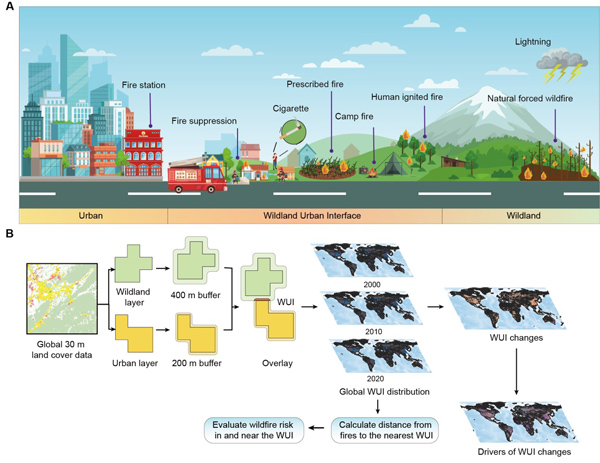A New Study Highlights the Rapid Growth of Wildland Urban Interface Globally and Associated Wildfire Risk
Rapid human expansion into natural landscapes, resulting in the growth of wildland urban interface (WUI), has heightened risks associated with wildfires.
Prof. WANG Jianghao’s team from the State Key Laboratory of Resources and Environmental Information System, Institute of Geographic Sciences and Natural Resources Research of Chinese Academy of Sciences have mapped global WUI changes in 2000, 2010, and 2020, revealing alarming upward trends in WUI areas.
This work, published in Science Advances, provides critical insights into how urbanization could intensify potential wildfire risk faced by humans worldwide.
Against the backdrop of the industrialization, human activity’s frequency and intensity have escalated, resulting in extensive natural land conversion into WUI areas. The most immediate conflicts between human society and the Earth system clustered in WUI, placing residents here at a higher risk of exposure to natural hazards, such as floods, landslides, and wildfires.
The increased occurrence of extreme and large wildfires, exacerbated by climate change, necessitates urgent attention to these hazards in WUI areas. Individuals living in and near the WUI would face elevated mortality risks due to exposure to flames and heat; wildfire-related smoke can also increase illness and death risks even at a distance up to 1,000 km. Therefore, understanding the dynamics of WUI growth and its underlying causes is critical for developing effective wildfire management strategies.

Conceptual diagram illustrating how human society and wildfire interact from distant wildlands to densely populated urban areas. (Image by GUO Yongxuan)
By 2020, global WUI areas have covered 1.44% of the terrestrial surface, with approximately 1.2 billion people residing in these areas. Over the past two decades, the WUI has expanded by more than a third, with 85% of new WUI observed between 2010 and 2020.
The Researchers highlighted that urbanization is the primary driver of WUI expansion, while changes in natural vegetation have a minimal impact. The acceleration of urban expansion also explained the uneven change in the WUI.
In addition, they explored the spatial relationship between WUI zones and fire activity and found that wildfires in and around the WUI tend to be dense but low intensity, indicating that the WUI is a fire-prone area. From 2010 to 2020, small fires increased within a 1-km buffer of the WUI, while fire activities decreased at least 3 km away, which may be attributed to the increase in human activities.
The study results showed that urbanization as a key driver of WUI expansion, contributed to increasing wildfire risks.
Reference:
Guo, Y., Wang, J., Ge, Y. & Zhou, C. Global expansion of wildland-urban interface intensifies human exposure to wildfire risk in the 21st century, Science Advances, 10, 2024. DOI: 10.1126/sciadv.ado9587.
Download attachments: